9 Ways to Improve NPS Response Rates
Read More
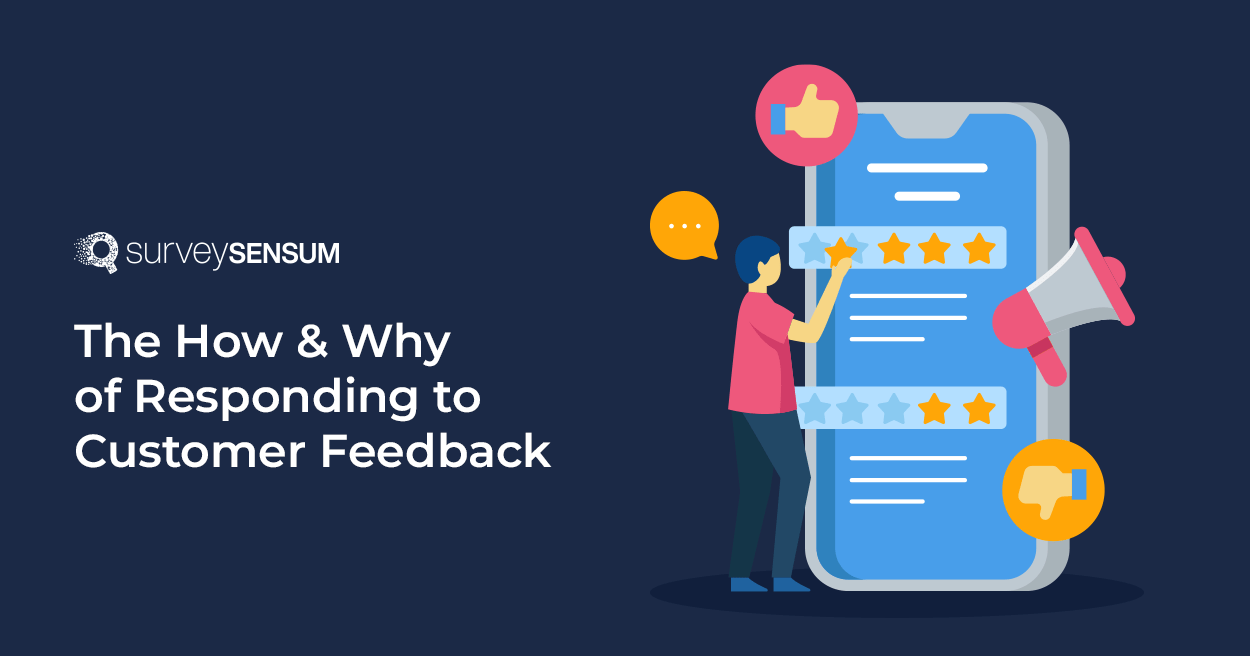
Did you know that a remarkable 77% of customers hold brands in higher esteem when they actively seek and diligently apply valuable customer feedback?
But what is customer feedback and why is it so important?
Customer feedback is the valuable insights provided by customers about their experiences with a product, service, or brand.
This is a great channel for customer to share their thoughts and experience with your brand. And responding to their feedback is not merely a courtesy – it is an important strategy for businesses that aim to become customer-centric.
When customers take the time to offer their feedback, it’s an opportunity for businesses to gain a deeper understanding of their needs, preferences, and pain points. Neglecting this can result in customer disengagement, lost opportunities for improvement, and damage to a company’s reputation.
But the question is, what is the right response?
Or how to respond in such a way that your customers feel that they did the right thing by interacting with you?
Well, inh this blog, we will talk about the importance of responding to customer feedback, how to do that it an effective customer feedback platform, and the dos and don’ts of responding to customer feedback. So, let’s jump right into it!
Why Respond to Customer Feedback?
How to Respond to Customer Feedback?
Do’s of Responding to Customer Feedback
Don’ts of Responding to Customer Feedback
But before we start talking about the do’s and don’t of responding to customer feedback, let’s first understand why it is important to respond to customer feedback.
Did you know that 83% of customers feel loyal to a brand that responds to and resolves their complaints?
And the best way to resolve customer complaints is by gathering, analyzing, and responding to customer feedback. When customers feel heard and valued, they are more likely to stick with your brand, make repeat purchases, and become advocates who recommend your products or services to others.
Customer feedback is a goldmine of insights for improving your offerings. It helps you identify areas where your products or services can be enhanced, ensuring that they meet or exceed customer expectations. Continuous improvement not only satisfies existing customers but also attracts new ones seeking high-quality experiences.
More than 99.9% of customers say they read reviews when shopping online at least sometimes.
In the age of online reviews and ratings, responding to customer feedback has a direct impact on your digital reputation. By addressing concerns and expressing gratitude for positive feedback, you can boost your ratings on platforms like Yelp, Google Reviews, etc. Higher ratings can attract more customers and instill trust.
Responding to customer feedback can provide a distinct competitive advantage in several ways:
Now that we understand the why, let’s focus on understanding the how of responding to customer feedback.
Here’s how you should respond to customer feedback.
Customers often have high expectations for quick resolutions to their issues and concerns.
Failing to respond promptly can lead to dissatisfaction and, in some cases, even customer attrition. Delayed responses can damage your brand’s reputation and hinder your ability to retain and attract customers.
For example, let’s say you posted on Twitter about a faulty product. But instead of replying to you immediately and taking timely action, the brand responded to you after two weeks, with a reply that said, “It is unfortunate that you faced this issue, kindly mail your issue to us”.
So, at this point do you think you even care about this brand? Do you think you will mail them the same problem again after two weeks?
No. This delayed action not only results in your dissatisfaction but also damages the brand’s image in the eyes of potential customers.
To ensure timely responses, it’s essential to set specific response time goals. For example, SurveySensum offers 2-hour SLA support on all channels (which led to 98% customer retention). So, here are some key steps to setting response time goals:
Delays can result in negative consequences, so set response time goals and strive to meet or exceed your customer expectations.
Positive feedback is a valuable asset for businesses, as it not only reinforces customer satisfaction but also presents opportunities for further engagement.
Here’s how to respond effectively to positive feedback:
Acknowledging, being specific, celebrating with your team, and utilizing positive feedback for upselling or cross-selling are effective ways to maximize the benefits of praise from satisfied customers.
Negative feedback is a nightmare for any brand, but let’s not ignore the valuable opportunity it presents to turn a dissatisfied customer into a loyal one.
Here’s how to respond effectively to negative feedback:
This approach not only addresses the immediate concern but also demonstrates your commitment to customer satisfaction and can potentially convert a dissatisfied customer into a loyal advocate.
Businesses often tend to ignore neutral feedback because it’s not exactly hurting them. But just like positive and negative feedback, neutral feedback also represents an opportunity to engage with your customers and enhance their experience.
Here’s how to respond to neutral feedback effectively:
By turning neutral feedback into a positive experience, you not only improve the current customer’s experience but also foster their loyalty and potentially lead to positive word-of-mouth referrals.
Customer feedback isn’t just about addressing individual comments – it’s your window to identify trends, anticipate future needs, and meet evolving customer expectations. So, here’s how to leverage customer feedback for this purpose:
Customer feedback, when analyzed effectively, can help your business stay ahead by identifying trends, anticipating future needs, and meeting evolving customer expectations.
Monitoring and follow-up are essential aspects of managing customer feedback effectively. These two steps ensure that customer concerns and suggestions are addressed properly.
Regularly tracking customer satisfaction and acting on customer feedback ensures that you continuously meet and exceed customer expectations, leading to improved customer loyalty and business success.
There you go! This is how you should respond to customer feedback. Now, let’s see some do’s and don’ts of responding to customer feedback.
Gather Customer Feedback With SurveySensum – Request a Demo
1. Say Thank You!
Express gratitude for the customer’s feedback, regardless of its nature. Let them know you appreciate their input, which can help you improve your products or services.
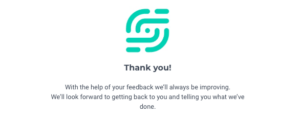
For example, Starred, a candidate experience analytics platform, thanks its customers sincerely after they have submitted their feedback.
2. Use Personalized, Friendly Language
Address the customer by name if possible and use a warm, friendly tone. Make the interaction feel personal and empathetic.
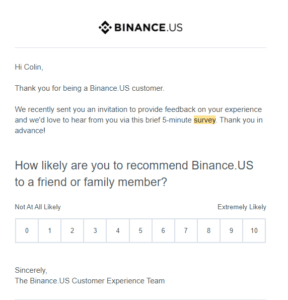
For example, Binance.US addresses its customers by name when asking about their likelihood of recommending Binance.US to friends and family members.
3. Highlight What You are Doing Right to Make Customers Happy
If some aspect of your business is gathering positive reviews, highlight that to your customers. Let them know what strategies and planning went behind it. This strengthens your customer relationship.
4. Ask Relevant Questions to Encourage Further Engagement
Show your interest in the customer’s opinions by asking follow-up questions. This encourages a two-way conversation and can provide more insights.
For example, you can ask,’ We’re glad you’re satisfied with our product. Is there anything specific you’d like to see improved or any additional features you’d find valuable?’
5. Invite Customers to Reach Out If They Need Help
Make it clear that your customer service is available and eager to assist. Encourage customers to contact you if they have further concerns or need assistance.
For example, you can say, ‘If you have any more questions or need further assistance, please don’t hesitate to contact us. We’re here to help.’
6. Apologize for the Negative Experience
If the feedback is negative, express genuine apologies for the customer’s experience. Show empathy and a commitment to making things right.
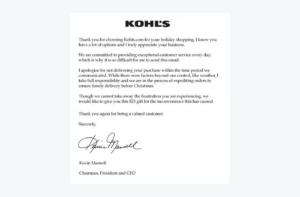
For example, Kohl’s CEO apologized to all customers who had bad experiences with the brand because of delays in deliveries over the Christmas holiday. This example shows why empathy is the answer to understand your customer better.
7. Keep It Positive
Even when addressing negative feedback, maintain a positive tone. Focus on solutions and improvements rather than dwelling on the problem.
For example, you can say, ‘While we’re sorry to hear about the issue, we appreciate your feedback as it helps us improve. We’re committed to making your next experience better.’
By following these, Do’s you can create a positive, and engaging dialogue with your customers, which not only resolves issues but also strengthens customer relationships and enhances your brand’s reputation.
So, these are all the Do’s, but what about the Don’ts?
1. Ignoring Any Type of Feedback
Don’t ignore any type of customer feedback, whether it’s positive, negative, or neutral. It can lead to customer frustration and a negative perception of your brand.
2. Responding Emotionally
Responding to feedback emotionally, especially negative ones, can escalate the situation and damage the customer relationship. Instead, respond professionally and empathetically.
3. Being Quick to Blame the Customers
Never blame the customers for their concerns or issues. Instead, take responsibility and focus on finding solutions. Blaming customers can alienate them and damage your reputation.
4. Failing to Follow Through on Promises
Don’t make promises to customers that you cannot or do not intend to keep. Failing to follow through on commitments can lower trust and make the customer experience even worse.
So, there you have it! The Do’s and Don’ts of responding to customer feedback. Let’s now see some brand examples that have excelled in responding to customer feedback.
Launch Your First Survey In Less Then 10 Minutes – Sign Up For Free!
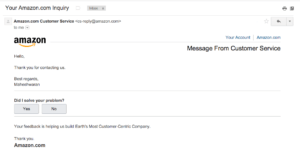
Amazon is a pioneer when it comes to gathering feedback at the right time through the right channels. It launches surveys at different touch points of a customer journey like post-purchase, post-customer service call, post-delivery, etc.
The surveys are always short and straightforward which tells the customer what exactly the survey is about and also doesn’t waste their time.
Apple hosts many out-of-the-box products and events and they fail to get feedback from their customers on each of those products or events. Whenever Apple launches a new product they send their customers ask about their experience with the product and their likelihood of recommending it to their friends and family.
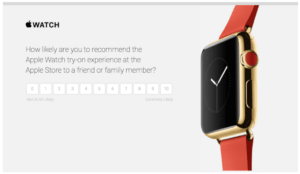
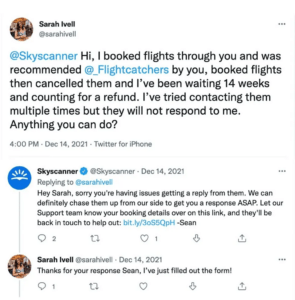
Online reviews and comments are just as important as feedback from surveys. Skyscanner shines in this area with its quick resolution of issues. Skyscanner’s social media team is active and responds to and resolves customer complaints very quickly.
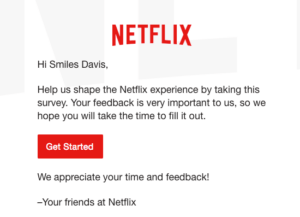
Netflix is a pioneer when it comes to personalized viewing experience. The algorithm reads customer watch history and references and recommends the best content for them. But that’s not it. Netflix also pays attention to the voice of customers and leverages the power of customer feedback to enhance its customer viewing experience.

When it comes to consistency in asking for feedback, one brand that comes to mind is Uber. After every ride, customers receive in-app surveys, as well as email surveys, to rate their ride experience with Uber. Here they can also give detailed feedback.
Customer feedback provides valuable insight into your customers’ needs, preferences, and expectations, but more often than not, brands ignore the important do’s and don’t of responding to customer feedback.
So, with this blog, we have provided you with a detailed process of how to respond to feedback and also the do’s and don’ts that you need to keep in mind when responding to customer feedback.
But that’s not enough. For effective feedback management, you need to invest in an efficient customer feedback tool like SurveySensum. This tool will allow you to create well-designed surveys, track and analyze your survey data in real time, resolve issues, and close the feedback loop in time.
